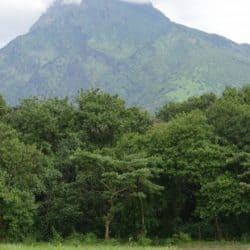Death of Mountain Gorillas in Research Groups in Volcanoes National Park in Rwanda
News | 19/05/10
KIGALI, RWANDA– The International Gorilla Conservation Program has just learned that one mother gorilla and three infant mountain gorillas have died in Volcanoes National Park in Rwanda, home to an estimated 380 of the highly endangered great apes. The deaths were discovered over a couple of days and coincided with heavy rains that have dramatically cooled temperatures and occasionally disrupted gorilla monitoring activities.
The Rwandan Development Board first learned of a problem on Sunday, May 16, when trackers from the Karisoke Research Center visiting the Pablo group reported they had found a dead female and her baby alive but very weak. As the trackers went to find the rest of the group they then discovered another dead baby gorilla. Fortunately, the second baby’s mother was found a day later with no signs of illness.
The trackers quickly called in veterinarians who unsuccessfully tried to revive the ailing gorilla.
On Monday morning, the death of another two-week-old gorilla was reported in Rwanda’s Ugenda group, which, along with the Pablo group, is monitored for research purposes only. Both groups are settled in the Karisimbi area of Rwanda’s Volcanoes National Park, the tallest of the volcanoes in the Virunga chain. While the cause of death has yet to be determined, the gorillas are thought to have died because of the extreme weather conditions. Baby gorillas are especially vulnerable to illness and other threats and rely heavily on the protection of their mothers well beyond their third year.
“Each baby mountain gorilla is a source of great hope and is monitored very closely,” says Eugene Rutagarama, Director of the International Gorilla Conservation Program, a coalition of the African Wildlife Foundation, Fauna & Flora International, and the World Wide Fund for Nature, formed to conserve Africa’s mountain gorillas. “We are all shocked and saddened by the death of these baby gorillas as well as the adult female, and by the grave implications for the mountain gorilla population as a whole.”
There only about 680 mountain gorillas in the wild, making them one of the world’s most highly endangered great apes. About half the population lives in the Virunga Volcanoes, a chain of active and inactive volcanoes that straddles the borders of Rwanda, Uganda, and the Democratic Republic of the Congo. The other half lives in Bwindi Impenetrable Park in Uganda, which last month suffered the loss of a mountain gorilla twin that was only one-and-a-half years old.
“Mountain gorilla twins are rare and it is rarer still to see twins survive past the first year-which is why we were very encouraged, and then greatly saddened by the death,” says Uganda-based Mark Mwine of IGCP. “Fortunately, the other twin is doing fine.”
Since the four dead gorillas were discovered, the Rwanda Development Board and Karisoke Research Centre staff have examined all other gorilla groups in Volcanoes National Park to confirm that there have been no further casualties.
“We can thankfully report that for all other research and tourism gorilla groups all individuals were identified,” says Maryke Gray, technical advisor for the International Gorilla Conservation Program. “There were no missing gorillas and no gorillas were found to have serious health problems.”
The news of the gorilla deaths is casting a pall over enthusiasm being generated by a mountain gorilla census now being conducted across the Virunga Volcanoes. Facilitated by IGCP and other partners, a team of 80 park officials and other experts over two months collected data on gorilla activity as well as fecal samples for genetic and health analysis. The results are now being analyzed and are expected to be released by the three park authorities in October. The last census of mountain gorillas in the Virunga Volcanoes, conducted in 2003, revealed the population had increased 17 percent since the previous census in 1989. IGCP and its partners are hoping to see another rise this time around.


